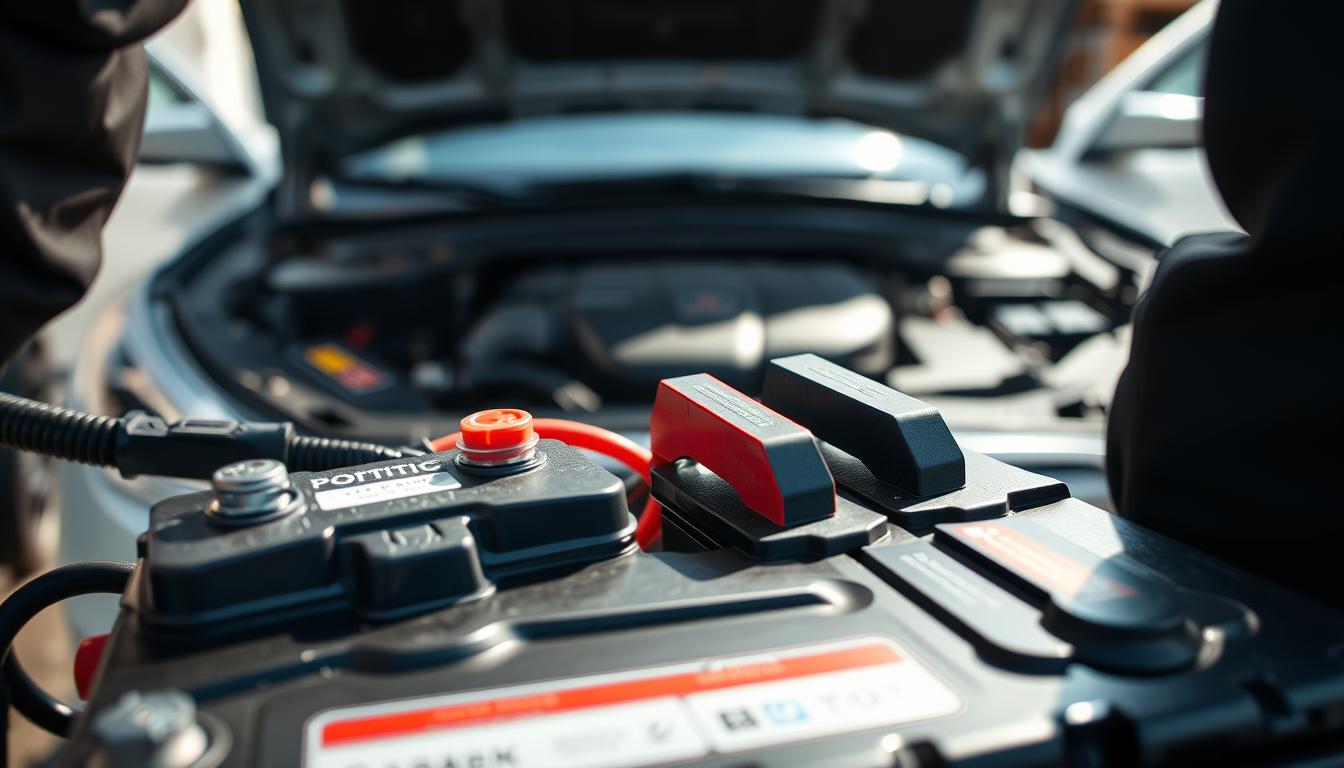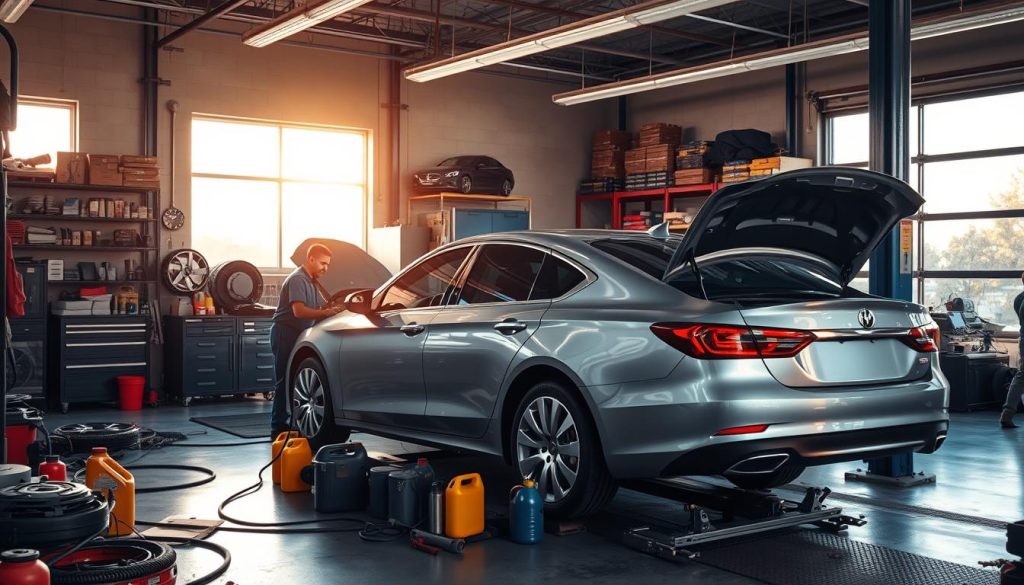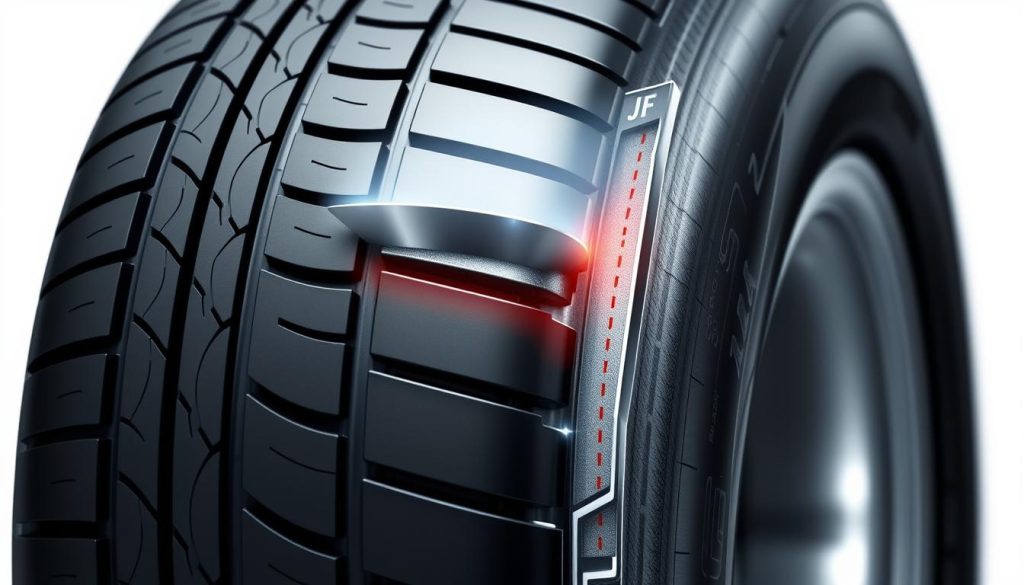A dead car battery can turn a routine day into a frustrating ordeal. Whether you’re rushing to work or stranded in a parking lot, understanding how to revive your vehicle quickly is crucial. At Heaven Automotive, we believe every driver should master this skill to handle emergencies confidently.
Modern cars rely heavily on electrical systems, making proper technique vital. Using jumper cables incorrectly risks damaging sensitive components or even causing injury. This guide breaks down the safest way to restore power while protecting your vehicle and yourself.
Batteries fail for many reasons—extreme temperatures, aging parts, or leaving lights on overnight. Recognizing these causes helps prevent future issues. If your car won’t start, stay calm. Check for obvious problems like loose connections before proceeding.
We’ll walk you through each step, from positioning vehicles safely to disconnecting cables correctly. While DIY methods work, never hesitate to call a professional if you’re unsure. Our team at Heaven Automotive is always ready to assist with expert car care services.
Key Takeaways
- Mastering proper techniques prevents damage to your vehicle’s electrical system.
- Dead batteries often result from weather, age, or accidental power drains.
- Safety gear like gloves and goggles is non-negotiable during the process.
- Follow a systematic approach to avoid sparks or incorrect connections.
- Professional help ensures safety if steps feel unclear or risky.
By the end of this guide, you’ll know exactly what you need to know to tackle this common issue. For complex scenarios or ongoing battery troubles, trust Heaven Automotive’s certified technicians to keep your car running smoothly.
Understanding Your Vehicle’s Battery and Safety Precautions
Modern vehicles depend on reliable battery systems to power everything from ignition to electronics. At Heaven Automotive, we prioritize educating drivers about their car battery’s anatomy and potential risks. Knowing what to look for – and what to avoid – could mean the difference between a quick fix and costly repairs.
Key Parts and Warning Signs
Your vehicle’s battery has two main terminals: positive (+) and negative (-). These metal connectors complete electrical circuits when properly charged. Common red flags include:
- Delayed engine cranking during startup
- Flickering interior lights or dim headlights
- Check engine or battery-shaped dashboard alerts
Most batteries last 3-5 years. Extreme heat accelerates wear, while cold reduces available power. If your vehicle struggles to start on chilly mornings, it’s time for an inspection.
Preventing Hazards
Always wear insulated gloves and safety goggles when handling cables. Remove watches or rings – metal conducts electricity and could cause burns. Before connecting anything:
- Check terminals for white corrosion buildup
- Inspect cables for frayed wires or cracks
- Ensure both vehicles are off during setup
Never attempt a boost if you spot leaks or swollen battery casing. Our Heaven Automotive technicians recommend professional assistance for damaged systems. A little caution protects both your car and personal safety.
Gathering Essential Tools and Equipment
Having reliable tools on hand transforms a stressful situation into a manageable task. At Heaven Automotive, we emphasize that jumper cables and a portable jump starter are non-negotiable items for every driver. These essentials ensure you’re prepared whether you’re in a crowded parking lot or a remote area.
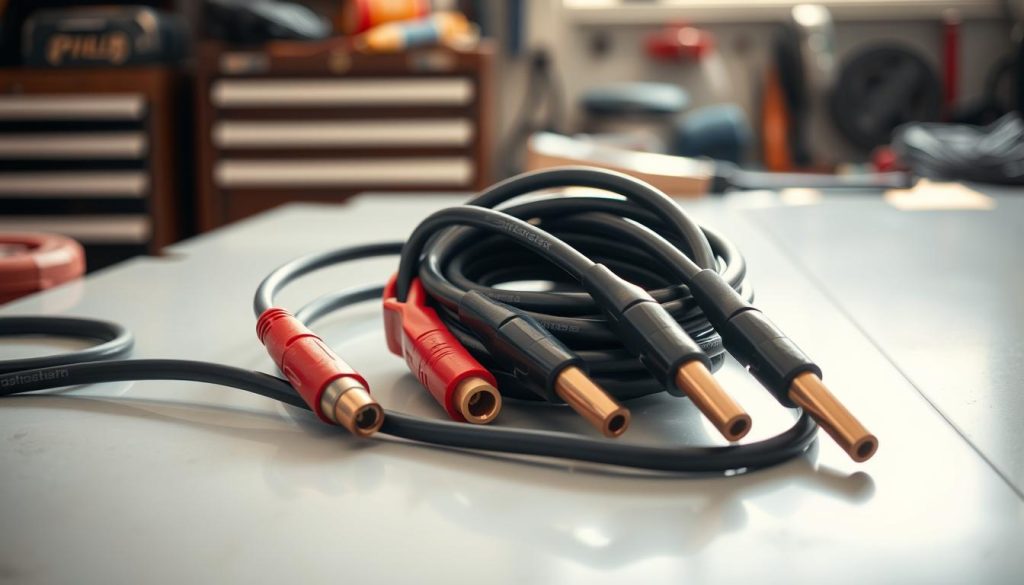
Choosing the Right Jumper Cables and Portable Jump Starter
Opt for jumper cables between 10-20 feet long – this range balances reach without significant power loss. Thicker cables (lower gauge numbers like 4 or 6) deliver stronger current flow. Always inspect for rust, fraying, or cracked insulation before use.
A portable jump starter eliminates the need for another vehicle. These compact devices provide instant power and fit easily in your trunk. Look for models with built-in safety features like reverse polarity alerts.
Complement your kit with:
- Insulated gloves to protect against shocks
- Safety glasses for eye protection
- Wire brushes to clean corroded terminals
Store equipment in a dry, temperature-stable area. Check cables every six months for wear, and recharge portable units quarterly. Investing in quality equipment ensures readiness when you need it most – a principle we stand by at Heaven Automotive.
Jump Starting Safely: A Step-by-Step Process
Reviving a vehicle requires precision and care to protect both cars and drivers. At Heaven Automotive, we outline this process to eliminate guesswork and ensure smooth power restoration. Follow these steps carefully to avoid sparks or electrical issues.
Secure Connections Matter
Park the working vehicle close to the disabled one, but ensure they don’t touch. Turn off both ignitions and set parking brakes. Attach the red clamp to the positive terminal (+) of the good battery first. Then, connect the other red clamp to the dead battery’s positive terminal.
Next, clamp the black clamp to the dead battery’s negative (-) terminal. The final black clamp goes to an unpainted metal surface on the donor car’s engine block – never the dead battery’s negative post. This prevents dangerous sparks.
Power Transfer and Startup
Start the working vehicle and let it idle for 3-5 minutes. Watch for dimming lights or unusual sounds. Attempt to start the disabled car. If it stalls, wait 2 more minutes before retrying.
Disconnecting Without Risks
Remove cables in reverse order: engine block clamp first, then dead battery’s negative. Follow with both red clamps. Keep the revived car running for 20 minutes to recharge. If problems persist, contact Heaven Automotive for expert diagnostics.
Tips for Using a Portable Jump Starter Effectively
Portable jump starters offer a lifeline when traditional methods aren’t an option. At Heaven Automotive, we recommend these compact devices as reliable backups for emergencies. Their self-contained design eliminates the need for another vehicle, making them ideal for remote areas or late-night breakdowns.
Ensuring the Jump Starter is Fully Charged
Always verify your unit’s charge before storing it. Most models display battery levels through LED indicators. Recharge monthly if unused – lithium-ion batteries lose power over time. A dead starter won’t help a dead battery, so treat it like your phone: keep it ready.
Following Manufacturer Instructions for Safe Use
Connect the red clamp to your battery’s positive terminal first. Attach the black clamp to an unpainted metal surface on the vehicle’s frame, not the negative post. Place the unit on stable ground away from the engine to prevent vibrations.
Turn on the starter and attempt to start the vehicle. If successful, let the engine run for 5 minutes before disconnecting. Remove clamps in reverse order, and recharge your portable unit immediately. Our team emphasizes reading brand-specific guides – details like surge protection settings vary.
Diagnosing Dead Battery Issues and When to Seek Help
When your vehicle starts reliably one day but falters the next, it’s more than an inconvenience – it’s a warning. At Heaven Automotive, we see many cases where repeated dead battery situations mask complex electrical problems. Understanding these red flags helps you decide when to handle it yourself or call our experts.
Identifying Signs of Battery Deterioration
Most car batteries last 3-5 years. If yours struggles after three winters or shows these symptoms, replacement may be overdue:
- Swollen casing from excessive heat exposure
- White crust on terminals blocking proper charge flow
- Dashboard lights flickering while driving
A faulty alternator often mimics battery failure. If your car dies shortly after jump-starting, test the alternator’s voltage output. Healthy systems maintain 13.7-14.7 volts when running.
Parasitic drain is another stealthy culprit. Faulty door switches or aging infotainment systems can siphon power overnight. Our technicians use multimeters to trace these hidden loads – a step DIY methods often miss.
Don’t ignore recurring issues. We’ve resolved cases where corroded wiring caused intermittent dead car scenarios. Trust our diagnostic tools when basic fixes fall short. Your vehicle deserves solutions, not endless boosts.
Common Mistakes When Jump Starting and How to Avoid Them
Even experienced drivers can make critical errors during emergency battery boosts. At Heaven Automotive, we’ve seen how small oversights lead to fried electronics or dangerous sparks. Let’s address frequent pitfalls so you can protect your car and stay safe.
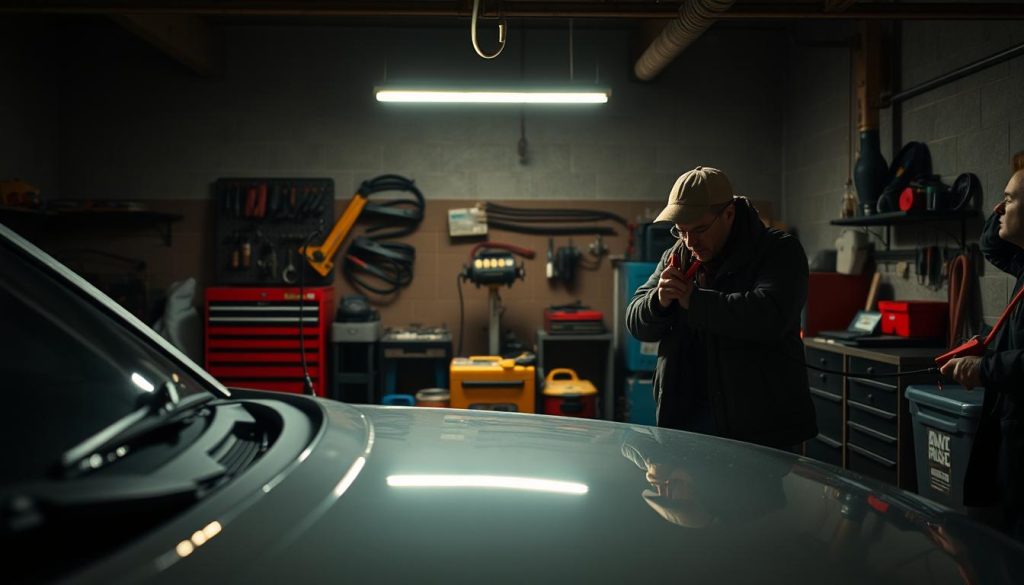
Terminal Confusion and Connection Risks
Mixing up clamps ranks as the top mistake. Always connect the red clamp to the dead battery’s positive (+) terminal first. Attaching the black clamp directly to the negative post creates spark risks – instead, ground it on unpainted metal like a bolt or bracket.
Three dangerous habits to eliminate:
- Crossed cables: Letting clamps touch during connections causes instant short circuits
- Wrong sequence: Energizing cables before proper attachment can surge systems
- Smoking near batteries: Hydrogen gas from aging units may ignite
Vehicle positioning matters too. Park donor cars close enough for cable reach without touching. Loose clamps often slip off during the process – double-check each connection’s grip. Our technicians recommend practicing the correct order before an emergency strikes.
If you hear popping sounds or smell burning plastic, stop immediately. These signs indicate improper setup. Trust Heaven Automotive’s experts to assess damage and prevent costly repairs. A moment of patience preserves your vehicle’s heart – its electrical system.
Post Jump Start: Maintenance and Recharging Tips
Proper care after reviving your vehicle ensures your battery’s longevity and prevents repeat failures. At Heaven Automotive, we stress that recharging practices directly impact electrical system health. Rushing to shut off the engine risks leaving your car battery in a weakened state.
Allowing Adequate Recharge Time After a Jump Start
Keep the engine running for 30 minutes minimum after a successful boost. Driving at highway speeds helps the alternator replenish battery charge faster than idling. Avoid short trips – multiple start-stop cycles drain power faster than it’s restored.
If your vehicle sits overnight and won’t start again, use a smart charger. These devices deliver controlled charge cycles to restore capacity safely. Never rely solely on your car’s charging system for full recovery after deep discharge.
Routine Battery Maintenance for Long-Term Reliability
Three essential habits prevent future issues:
- Clean terminals monthly with baking soda and water
- Test battery voltage every 3 months
- Inspect cables for corrosion or wear
Extreme temperatures accelerate wear. Park in shaded areas during summer and use insulation blankets in winter. Our Heaven Automotive technicians recommend professional testing if your vehicle needs weekly boosts – it signals failing components.
Remember: A healthy car battery holds 12.6 volts when fully charged. Values below 12.4V require immediate attention. Trust our team for accurate diagnostics and replacement guidance tailored to your driving needs.
Conclusion
A reliable vehicle starts with understanding the correct procedures for battery recovery. Following the right steps – from cleaning terminals to securing clamps on an unpainted metal surface – protects your car’s electrical system. Quality cables and methodical connections make this process efficient.
Persistent dead battery issues often signal deeper problems. Flickering lights or swollen casings demand expert attention. While DIY methods work temporarily, recurring failures mean it’s time for professional diagnostics.
At Heaven Automotive, we specialize in car electrical systems and battery services. Our technicians use advanced tools to pinpoint issues you might miss. Whether it’s a faulty alternator or parasitic drain, we restore your vehicle’s power reliably.
Don’t risk further damage with repeated jump attempts. Trust our certified team for lasting solutions. Contact us today – we’ll keep your car running smoothly and safely.

